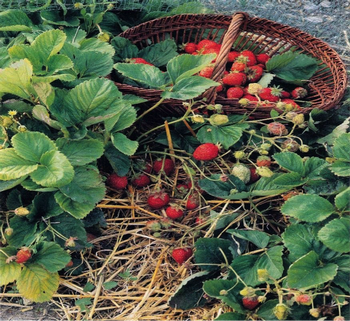Strawberry
-
Scientific NameFragaria spp.
-
General InformationStrawberries are perennial, low growing, vining plants that produce edible, heart-shaped berries. The tiny yellow or black dots on the berry’s surface are called achenes and are the actual fruit.
 Photo: Anne-Marie Walker, Potager du Roi, Versailles
Photo: Anne-Marie Walker, Potager du Roi, Versailles -
When to Plant
Middle to late August is generally the best time to plant strawberries. Short day or "June bearing" cultivars planted in August yield a small crop in the fall and a larger crop the following spring through summer. Day neutral or "everbearing" cultivars may be planted in the fall or early spring for spring through fall production. Replant every two to three years with new starts. Note: day neutral plants bear longer, but short day cultivars produce higher quality berries.
-
Planting
For best root health, plant strawberries in containers, planter boxes, or beds that are at least 12 inches deep. Select a sunny site where plants susceptible to verticillium wilt (tomatoes, potatoes) and other berry crops have not been grown.
Planting in beds: After the soil is prepared, make raised beds about six inches high and 10 inches wide if you are planting one row of plants, and 18 inches wide if planting two rows. Orient beds in a north south direction for best exposure. Dig a hole about four to six inches deep, or as deep as the crown. Fan out the roots and keep midpoint of crown even with the soil surface. Firm soil around the plant and water deeply. Space plants in rows about 10 to 12 inches apart. Copper barriers along the perimeter will help keep snails and slugs out. 25 plants feed a family of four.
-
Soil Requirements
Strawberries do best in well-drained sandy loam. Heavier soils may be improved by adding organic amendments such as aged manure, compost, and leaf mold weeks to months prior to planting. Strawberries do well in soil with pH of 5 to 7.0.
-
Water Requirements
Water regularly.
-
Fertilizing
Make sure new plantings have adequate phosphorous. At each planting spot, add about 1 teaspoon of an organic fertilizer blend, in the range of 5-10-10, to bottom of planting hole. Cover with soil and plant the strawberry crown on top. Lightly apply a source of nitrogen, such as fish emulsion, every four weeks during the growing season. In spring, add a slow release fertilizer, such as organic fertilizer pellets, before adding mulch. Some growers recommend plastic mulch. Organic mulch alternatives include pine needles or oak leaves.
-
Pollination
Pollinated by bees and wind.
-
Harvesting
Harvest from March through November when fruit is mostly red with stem on. Pick in the morning when fruit is cool. Ripe fruit generally appears about 30 days after the blossom. Both short day and day neutral cultivars have the heaviest production in May and June, but will produce for months as long as temperatures do not get too hot. Fruit production is highest in the first year and declines after that. Provide shade to harvested fruit held in the garden. Remove fruit from the garden one to two hours after harvest.
-
Storage
Do not wash berries until just before using. Cool as quickly as possible after harvest. Depending upon ripeness at harvest, strawberries may keep for a few days in the refrigerator. Place in a partially open plastic bag in a crisper drawer with higher humidity. Berries may be frozen or dried.
-
Good Varieties for Marin
Day neutral/everbearing: ‘Seascape’ ‘Albion’ ‘Tri-star’ ‘Quinalt’ (good for containers)
Short day: ‘Aromas’ ‘Chandler’ ‘Sequoia’
-
Helpful Tips
Prune off all runners as they develop. They weaken the mother plant and reduce fruit size. Remove dead leaves in the spring.
-
Common Problems
Verticillium wilt -- practice crop rotation when replanting.
Root rot -- throw away infected plants and reduce irrigation.
Botrytis fruit rot -- separate fruit from ground with mulch.
-
Pests- Diseases & More
Spider mites -- hose off.
Aphids -- hose off.
Leaf-rolling caterpillars -- pick off.
Slugs and snails -- pick off in early morning and/or use copper around the perimeter of bed.
Learn more about growing strawberries.

